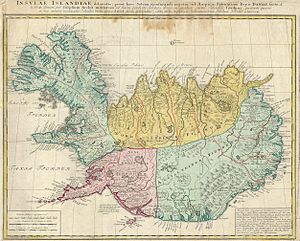- Farthings of Iceland
-
Historically, Iceland was divided into four landsfjórðungar (singular landsfjórðungur) or farthings, that were named after the Cardinal directions. These were administrative divisions established in 965 for the purpose of organising regional assemblies (fjórðungsþing - farthing assemblies) and for regional courts (fjórðungsdómar - farthing courts). Each farthing contained three local assemblies (held in spring and autumn) except the Norðlendingafjórðungur which had four. Each farthing also contained nine goðorð presided over by a chieftain, goði as three goðar formed one assembly, again, except the north farthing which had twelve. Farthing courts would decide on judgement if both plaintiff and defendant belonged to the same assembly, otherwise the case was brought up to the general assembly Alþingi. Otherwise little is known about these farthing assemblies and they seem to have been much more irregular than the spring and autumn assemblies. Also, in spite of the apparent regularity of 3 goði per assembly and 3-4 assemblies per farthing, the system of rule by chieftains and assemblies probably followed a much more varied pattern.
The two dioceses of Iceland were divided along the farthing division in 1106 such that the diocese of Skálholt extended over three farthings (west, south and east) and the diocese of Hólar extended over the north farthing.
Contents
The lawmen
After Iceland entered into personal union with Norway in 1264 a change of law with the new lawbook of king Magnus of Norway came into effect in 1271. According to this book, Járnsíða (Ironside), a lawman was set over each farthing. Usually there were just two lawmen, one for the north and west farthings and one for the south and east farthings, but sometimes there were as many as four. At the same time the old assemblies muted into counties (sýslur) and the goði-chieftains were replaced by county sheriffs (sýslumaður) an office awarded by the king. The lawmen gradually became very powerful and the institution of a supreme court (yfirdómur) in 1593 was an attempt to curb their power instigated by their main competitors, the two bishops.
Medical districts
In 1683 Iceland was made an amt within the kingdom of Denmark-Norway. In 1770 the country was divided into two amts, the South- and West Amt and the North- and East Amt and the borders of the farthings were changed according to the new division. In effect, the farthings were replaced by the amts.
In 1651 the king had granted permission for the construction of one hospital in each farthing. These were not hospitals in the modern sense but primarily intended as lazarets or leper colonies that later became shelters for vagrants and beggars. In 1766 the office of farthing doctor (fjórðungslæknir) was created, one for each farthing. Soon, however, the medical districts were further divided, first with the introduction of another doctor for the west farthing in 1781 and then another for the eastern part of the south farthing in 1799. For most of the 19th century these were the six medical districts in Iceland. In 1944 the state agreed to increase their funding of three hospitals outside of Reykjavík which would be designated as farthing hospitals (fjórðungssjúkrahús). These were the hospitals of Ísafjörður, Akureyri and Neskaupstaður.
Contemporary use of the term
Later administrative divisions of Iceland (notably the voting districts established with the Constitution of Iceland in 1874) were based on the division of counties and municipalities and the farthings gradually lost any official significance although they are still used in common parlance to refer to parts of the country.
Currently there is only one form of local government in Iceland, the municipalities, the counties themselves having lost any official significance in the 1990s. Several times during the 20th century there have been regional organisations, societies, cooperation venues at the municipal level etc. based on the farthings. The farthings were also mentioned e.g. when one long wave-antenna was built for each farthing in the 1950s and in 1980 one Jóhannes Árnason suggested reinstating the farthing assemblies as means of distributing power from the state to the regions, but this was not seriously considered. A more common way of dividing Iceland nowadays is the eight regions (landshlutar).
Farthing divisions
- Vestfirðingafjórðungur, or Breiðfirðingafjórðungur (Westfjord farthing), which included the Westfjords but reached down to the middle of Faxaflói, so it also included most of today's west region. The southern border was originally at Hvítá in Borgarfjörður but in the 13th century this was moved south to Botnsá in Hvalfjörður.
- Norðlendingafjórðungur, or Eyfirðingafjórðungur (North farthing), which reached from Hrútafjörður in the west to Langanes in the east (the same as today's northeast and northwest regions);
- Austfirðingafjórðungur (Eastfjord farthing) extended from Langanes to Jökulsá á Sólheimasandi in the south. In 1783 when Iceland was divided into amts, however, Skaftafellssýsla in the south was placed within the South Amt and the border of the farthings thus moved to Lónsheiði. The county of Skaftafellssýsla was later divided into two constituencies Austur-Skaftafellssýsla (east) and Vestur-Skaftafellssýsla (west) and in 1893 the eastern half was made part of the East Amt. Hence the border between the south and the east farthing moved again, this time to Skeiðará and the east farthing thus became similar to today's east region.
- Sunnlendingafjórðungur, or Rangæingafjórðungur (South farthing) which was really only the south-west part of the country, including the southern peninsula, what is today the capital region and what was left of the south farthing, Árnessýsla and Rangárvallasýsla until 1783 when Skaftafellssýsla was added. Now it includes the south-west and capital region along with Vestur-Skaftafellssýsla.
See also
Categories:- Country subdivisions of Europe
- Subdivisions of Iceland
Wikimedia Foundation. 2010.

